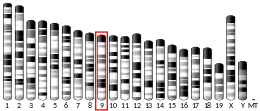MFRP
Membrane frizzled-related protein is a protein that in humans is encoded by the MFRP gene.[5][6]
| MFRP | |||||||||||||||||||||||||
|---|---|---|---|---|---|---|---|---|---|---|---|---|---|---|---|---|---|---|---|---|---|---|---|---|---|
| Identifiers | |||||||||||||||||||||||||
| Aliases | MFRP, MCOP5, NNO2, RD6, membrane frizzled-related protein, CTRP5 | ||||||||||||||||||||||||
| External IDs | OMIM: 606227 MGI: 2385957 HomoloGene: 12866 GeneCards: MFRP | ||||||||||||||||||||||||
| |||||||||||||||||||||||||
| |||||||||||||||||||||||||
| |||||||||||||||||||||||||
| Orthologs | |||||||||||||||||||||||||
| Species | Human | Mouse | |||||||||||||||||||||||
| Entrez | |||||||||||||||||||||||||
| Ensembl | |||||||||||||||||||||||||
| UniProt | |||||||||||||||||||||||||
| RefSeq (mRNA) | |||||||||||||||||||||||||
| RefSeq (protein) | |||||||||||||||||||||||||
| Location (UCSC) | Chr 11: 119.34 – 119.35 Mb | Chr 9: 44.1 – 44.11 Mb | |||||||||||||||||||||||
| PubMed search | [3] | [4] | |||||||||||||||||||||||
| Wikidata | |||||||||||||||||||||||||
| |||||||||||||||||||||||||
References
- GRCh38: Ensembl release 89: ENSG00000235718 - Ensembl, May 2017
- GRCm38: Ensembl release 89: ENSMUSG00000034739 - Ensembl, May 2017
- "Human PubMed Reference:". National Center for Biotechnology Information, U.S. National Library of Medicine.
- "Mouse PubMed Reference:". National Center for Biotechnology Information, U.S. National Library of Medicine.
- Katoh M (Mar 2001). "Molecular cloning and characterization of MFRP, a novel gene encoding a membrane-type Frizzled-related protein". Biochem Biophys Res Commun. 282 (1): 116–23. doi:10.1006/bbrc.2001.4551. PMID 11263980.
- "Entrez Gene: MFRP membrane frizzled-related protein".
Further reading
- Metlapally R, Li YJ, Tran-Viet KN, et al. (2008). "Common MFRP sequence variants are not associated with moderate to high hyperopia, isolated microphthalmia, and high myopia". Mol. Vis. 14: 387–93. PMC 2268852. PMID 18334955.
- Ayala-Ramirez R, Graue-Wiechers F, Robredo V, et al. (2007). "A new autosomal recessive syndrome consisting of posterior microphthalmos, retinitis pigmentosa, foveoschisis, and optic disc drusen is caused by a MFRP gene mutation". Mol. Vis. 12: 1483–9. PMID 17167404.
- Yang L, Yamasaki K, Shirakata Y, et al. (2006). "Bone morphogenetic protein-2 modulates Wnt and frizzled expression and enhances the canonical pathway of Wnt signaling in normal keratinocytes". J. Dermatol. Sci. 42 (2): 111–9. doi:10.1016/j.jdermsci.2005.12.011. PMID 16442268.
- Pauer GJ, Xi Q, Zhang K, et al. (2006). "Mutation screen of the membrane-type frizzled-related protein (MFRP) gene in patients with inherited retinal degenerations". Ophthalmic Genet. 26 (4): 157–61. doi:10.1080/13816810500374425. PMID 16352475. S2CID 43634962.
- Mandal MN, Heckenlively JR, Burch T, et al. (2005). "Sequencing arrays for screening multiple genes associated with early-onset human retinal degenerations on a high-throughput platform". Invest. Ophthalmol. Vis. Sci. 46 (9): 3355–62. doi:10.1167/iovs.05-0007. PMID 16123440.
- Sundin OH, Leppert GS, Silva ED, et al. (2005). "Extreme hyperopia is the result of null mutations in MFRP, which encodes a Frizzled-related protein". Proc. Natl. Acad. Sci. U.S.A. 102 (27): 9553–8. doi:10.1073/pnas.0501451102. PMC 1172243. PMID 15976030.
- Ota T, Suzuki Y, Nishikawa T, et al. (2004). "Complete sequencing and characterization of 21,243 full-length human cDNAs". Nat. Genet. 36 (1): 40–5. doi:10.1038/ng1285. PMID 14702039.
- Hayward C, Shu X, Cideciyan AV, et al. (2004). "Mutation in a short-chain collagen gene, CTRP5, results in extracellular deposit formation in late-onset retinal degeneration: a genetic model for age-related macular degeneration". Hum. Mol. Genet. 12 (20): 2657–67. doi:10.1093/hmg/ddg289. PMID 12944416.
This article is issued from Wikipedia. The text is licensed under Creative Commons - Attribution - Sharealike. Additional terms may apply for the media files.



